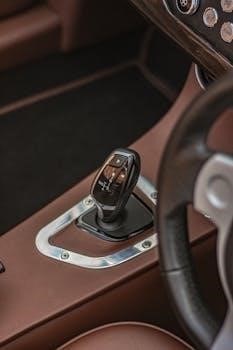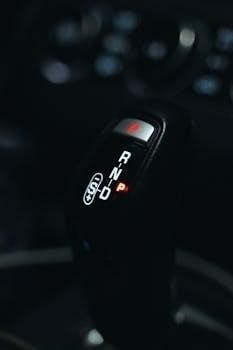
automatic transmission with manual valve body
Manual valve bodies transform automatic transmissions, offering drivers direct shift control. Unlike standard automatics, these systems require manual gear changes, similar to a manual transmission but without a clutch. This modification enhances driver engagement and control.
Understanding the Valve Body’s Role
The valve body acts as the central nervous system of an automatic transmission, dictating its operations. It contains numerous springs, valves, and fluid passages crucial for proper function. It manages fluid pressure and flow to control gear shifts; In essence, it tells the transmission when and how to shift gears. Modifying the valve body, such as converting to a manual valve body, alters these functions, giving the driver direct control over gear selection, instead of relying on the automatic functionality for shifting gears.

Automatic vs. Manual Valve Bodies⁚ Key Differences
Automatic valve bodies shift gears automatically using hydraulic pressure and computer control. Manual valve bodies require the driver to physically shift gears, offering a more direct driving experience.
Automatic Valve Body Operation
Automatic valve bodies function as the central nervous system of an automatic transmission. They utilize a network of springs, valves, and fluid passages to control gear shifts. These systems rely on hydraulic pressure and computer inputs to determine when and how to shift gears automatically. This intricate process allows for seamless transitions between gears without any driver intervention, optimizing performance and efficiency based on various driving conditions and vehicle parameters. The automatic system handles all shift decisions.
Manual Valve Body Operation
Manual valve bodies, in contrast, eliminate the automatic shifting function, placing gear selection directly in the hands of the driver. Unlike automatic systems, manual valve bodies do not rely on computer inputs for shifting decisions. Instead, the driver must manually shift through each gear, much like a manual transmission, but without the need for a clutch; This direct control is achieved through a modified valve body that responds to the driver’s shifter inputs, resulting in immediate and precise gear changes.
How Manual Valve Bodies Work
Manual valve bodies function by rerouting hydraulic fluid within the transmission. This allows drivers to control shifts directly, bypassing the automatic system. This direct control enhances the transmission’s response to driver input.
Shift Control and Operation
With a manual valve body, the driver assumes complete control over gear selection. Unlike an automatic transmission that shifts based on speed and load, a manual valve body requires the driver to physically shift to each gear. This is accomplished using a shifter, often a ratcheting type, providing a more engaging and responsive driving experience. The transmission will not shift automatically; every shift must be initiated by the driver, much like a manual transmission without a clutch. This direct manipulation ensures precise gear selection at all times.
Line Pressure and its Impact
Manual valve bodies often increase line pressure within the transmission. This higher pressure results in firmer and quicker shifts, reducing clutch slippage. Increased line pressure is particularly beneficial in high-performance applications where quick gear changes are crucial. However, this can also lead to increased wear on transmission components if not carefully managed. The consistent high pressure from a manual valve body can influence the overall life and performance characteristics of the transmission system and should be carefully considered.
Pros and Cons of Using a Manual Valve Body
Manual valve bodies offer enhanced control and quicker shifts, beneficial for racing. However, they remove automatic shifting, which can be inconvenient for daily driving, requiring constant manual gear changes.
Benefits in Racing and Off-Road Applications
In racing, manual valve bodies provide precise shift control, allowing drivers to maintain optimal engine RPMs, leading to faster acceleration and better lap times. Off-road, they enable drivers to hold specific gears, improving traction and control on challenging terrains. The manual control reduces shift overlaps, ensuring quick and firm gear changes. This positive shifting and increased line pressure contribute to enhanced performance and reliability in demanding driving conditions.
Drawbacks for Street Use
Daily driving with a manual valve body can be cumbersome, requiring constant shifting. The absence of automatic shifting means the driver must manually select each gear, which can become tedious in stop-and-go traffic. Additionally, most manual valve bodies run full line pressure at all times, potentially causing a harsher ride and accelerated wear on transmission components. This modification, while beneficial for performance, significantly reduces driving convenience for normal street conditions and is not generally recommended.

Installation and Maintenance of Manual Valve Bodies
Installing a manual valve body often requires specialized knowledge and tools. Due to their complexity, professional installation is usually recommended, and ongoing maintenance might involve more frequent checks and adjustments.
Complexity and DIY Considerations
The installation of a manual valve body is not a straightforward task and often requires a deep understanding of transmission mechanics. DIY attempts can lead to critical errors, potentially damaging the transmission. This modification isn’t just about swapping parts; it’s about reconfiguring the transmission’s control system. Therefore, professional installation by an experienced mechanic is generally advised. Incorrect assembly or poor tuning can result in reduced transmission performance, or even a complete failure of the transmission. Consider the risks before attempting a DIY installation of a manual valve body.
Manual Valve Body Shifting Mechanisms
Manual valve bodies necessitate a driver-controlled shift, often utilizing a ratcheting shifter. This setup allows for precise gear selection, eliminating automatic upshifts or downshifts, and enhancing driver control.
Shifting Patterns and Ratcheting Shifters
Manual valve bodies often employ a distinct shifting pattern, deviating from the typical automatic sequence. These patterns, which can be forward or reverse, dictate the order of gear engagement. Ratcheting shifters are frequently paired with manual valve bodies, providing a positive, click-stop action between gears. This precise mechanism prevents accidental gear changes and offers a more robust, tactile feel. The ratcheting design ensures that shifts are deliberate and controlled, enhancing the overall driving experience, especially in performance-oriented applications where gear selection needs to be accurate and quick.
Common Misconceptions About Manual Valve Bodies
A frequent misconception is that manual valve bodies function like manual transmissions with a clutch. They do not; they eliminate automatic shifting and require driver-initiated gear changes without a clutch.
Engine Braking and Shifting
Engine braking with a manual valve body depends on its design; forward pattern valve bodies generally provide engine braking, whereas reverse patterns may not. Proper shifting technique is crucial, as the transmission will not automatically downshift. Drivers must manually select each gear, much like a manual transmission without a clutch. Using a ratcheting shifter can help provide more precise control over the gear selection when using a manual valve body. This precise control allows drivers to hold gears longer and to maximize performance.

Impact on Drivetrain Lifespan
Manual valve bodies can affect drivetrain lifespan. The increased line pressure can be tough on components. Proper installation and maintenance are crucial to minimize potential issues and extend the life of the transmission.
Potential Issues and Solutions
Using a manual valve body can lead to increased wear on transmission components due to higher line pressure. This can cause premature failure of clutches and other internal parts. Proper installation is critical, as are ensuring the transmission is correctly matched to the vehicle’s needs to avoid mishaps. Regularly checking and maintaining the transmission fluid is also vital to managing the higher stress loads. Additionally, a ratcheting shifter is often recommended for more precise shifting, helping to reduce strain and control shifts more effectively.
Popular Manual Valve Body Options and Brands
Several brands offer manual valve bodies, including Art Carr and TCI Automotive, known for quality and performance. These brands provide various models suitable for different transmission types and performance needs.
Examples of Available Models
Popular models include the Art Carr manual valve body, often used in TH400 transmissions, and various offerings from TCI Automotive. These models cater to different needs, such as standard or reverse shift patterns; Some valve bodies are designed for specific transmissions, like the 4L60E or the TH400, each offering unique features for enhanced shifting. Choices range from full manual control to options that retain some automatic functionality, allowing drivers to select the best setup.

Choosing the Right Valve Body
Selecting a valve body requires careful consideration of driving needs. Manual valve bodies suit racing and off-road, while automatic types better serve daily use. Informed decisions are crucial.
Making an Informed Decision
Choosing between an automatic and manual valve body depends heavily on your vehicle’s intended use. For daily driving, the convenience of an automatic transmission generally outweighs the benefits of manual control. However, in racing or off-road scenarios, the precise control offered by a manual valve body can be advantageous, allowing for quicker shifts and holding gears at peak RPM. Evaluate the trade-offs regarding daily driveability versus performance enhancements before making a decision. Consider also the increased maintenance requirements associated with full manual valve bodies.